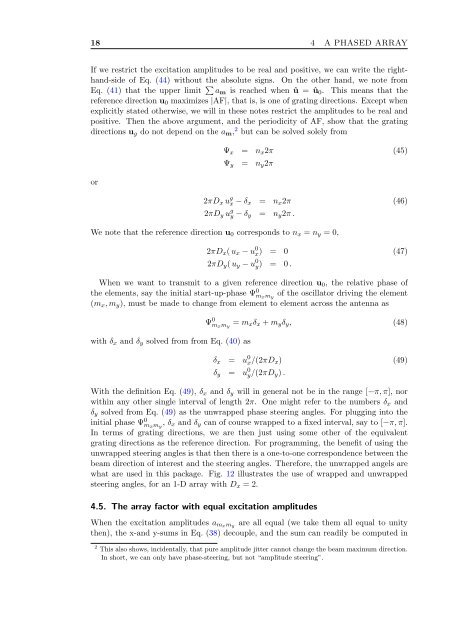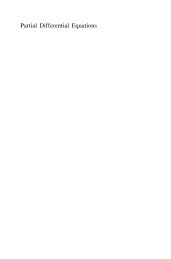a Matlab package for phased array beam shape inspection
a Matlab package for phased array beam shape inspection
a Matlab package for phased array beam shape inspection
Create successful ePaper yourself
Turn your PDF publications into a flip-book with our unique Google optimized e-Paper software.
18 4 A PHASED ARRAY<br />
If we restrict the excitation amplitudes to be real and positive, we can write the righthand-side<br />
of Eq. (44) without the absolute signs. On the other hand, we note from<br />
Eq. (41) that the upper limit ∑ a m is reached when û = û 0 . This means that the<br />
reference direction u 0 maximizes |AF|, that is, is one of grating directions. Except when<br />
explicitly stated otherwise, we will in these notes restrict the amplitudes to be real and<br />
positive. Then the above argument, and the periodicity of AF, show that the grating<br />
directions u g do not depend on the a m , 2 but can be solved solely from<br />
or<br />
Ψ x = n x 2π (45)<br />
Ψ y = n y 2π<br />
2πD x u g x − δ x = n x 2π (46)<br />
2πD y u g y − δ y = n y 2π .<br />
We note that the reference direction u 0 corresponds to n x = n y = 0,<br />
2πD x ( u x − u 0 x) = 0 (47)<br />
2πD y ( u y − u 0 y) = 0 .<br />
When we want to transmit to a given reference direction u 0 , the relative phase of<br />
the elements, say the initial start-up-phase Ψ 0 m xm y<br />
of the oscillator driving the element<br />
(m x , m y ), must be made to change from element to element across the antenna as<br />
with δ x and δ y solved from from Eq. (40) as<br />
Ψ 0 m xm y<br />
= m x δ x + m y δ y , (48)<br />
δ x = u 0 x/(2πD x ) (49)<br />
δ y = u 0 y/(2πD y ) .<br />
With the definition Eq. (49), δ x and δ y will in general not be in the range [−π, π], nor<br />
within any other single interval of length 2π. One might refer to the numbers δ x and<br />
δ y solved from Eq. (49) as the unwrapped phase steering angles. For plugging into the<br />
initial phase Ψ 0 m xm y<br />
, δ x and δ y can of course wrapped to a fixed interval, say to [−π, π].<br />
In terms of grating directions, we are then just using some other of the equivalent<br />
grating directions as the reference direction. For programming, the benefit of using the<br />
unwrapped steering angles is that then there is a one-to-one correspondence between the<br />
<strong>beam</strong> direction of interest and the steering angles. There<strong>for</strong>e, the unwrapped angels are<br />
what are used in this <strong>package</strong>. Fig. 12 illustrates the use of wrapped and unwrapped<br />
steering angles, <strong>for</strong> an 1-D <strong>array</strong> with D x = 2.<br />
4.5. The <strong>array</strong> factor with equal excitation amplitudes<br />
When the excitation amplitudes a mxmy<br />
are all equal (we take them all equal to unity<br />
then), the x-and y-sums in Eq. (38) decouple, and the sum can readily be computed in<br />
2 This also shows, incidentally, that pure amplitude jitter cannot change the <strong>beam</strong> maximum direction.<br />
In short, we can only have phase-steering, but not “amplitude steering”.
















